Cells within cells: Rickettsiales and the obligate intracellular bacterial lifestyle
The Rickettsiales are a group of obligate intracellular vector-borne Gram-negative bacteria that include many organisms of clinical and agricultural importance, including Anaplasma spp., Ehrlichia chaffeensis, Wolbachia, Rickettsia spp. and Orientia tsutsugamushi. This Review provides an overview of the current state of knowledge of the biology of these bacteria and their interactions with host cells, with a focus on pathogenic species or those that are otherwise important for human health. This includes a description of rickettsial genomics, bacterial cell biology, the intracellular lifestyles of Rickettsiales and the mechanisms by which they induce and evade the innate immune response.
This is a preview of subscription content, access via your institution
Access options
Access Nature and 54 other Nature Portfolio journals
Get Nature+, our best-value online-access subscription
cancel any time
Subscribe to this journal
Receive 12 print issues and online access
206,07 € per year
only 17,17 € per issue
Buy this article
- Purchase on SpringerLink
- Instant access to full article PDF
Prices may be subject to local taxes which are calculated during checkout
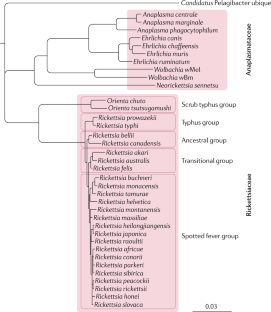
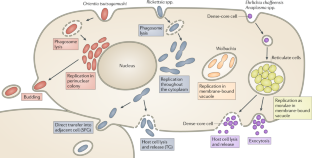
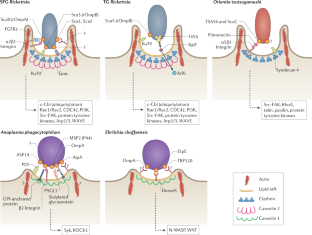
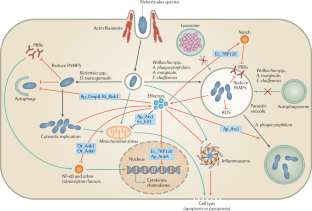
Similar content being viewed by others
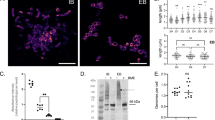
The obligate intracellular bacterium Orientia tsutsugamushi differentiates into a developmentally distinct extracellular state
Article Open access 23 June 2022
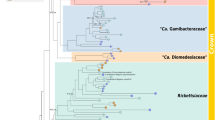
Host association and intracellularity evolved multiple times independently in the Rickettsiales
Article Open access 06 February 2024
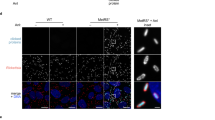
Cell-selective proteomics reveal novel effectors secreted by an obligate intracellular bacterial pathogen
Article Open access 18 July 2024
References
- Casiraghi, M. et al. Phylogeny of Wolbachia pipientis based on gltA, groEL and ftsZ gene sequences: clustering of arthropod and nematode symbionts in the F supergroup, and evidence for further diversity in the Wolbachia tree. Microbiology151, 4015–4022 (2005). ArticleCASPubMedGoogle Scholar
- Gillespie, J. et al. Plasmids and rickettsial evolution: insight from Rickettsia felis. PLoS ONE2, e266 (2007). ArticlePubMedPubMed CentralGoogle Scholar
- Gillespie, J. et al. Rickettsia phylogenomics: unwinding the intricacies of obligate intracellular life. PLoS ONE3, e2018 (2008). ArticlePubMedPubMed CentralGoogle Scholar
- Renvoisé, A., Merhej, V., Georgiades, K. & Raoult, D. Intracellular Rickettsiales: insights into manipulators of eukaryotic cells. Trends Mol. Med.17, 573–583 (2011). ArticlePubMedGoogle Scholar
- Werren, J., Baldo, L. & Clark, M. Wolbachia: master manipulators of invertebrate biology. Nat. Rev. Microbiol.6, 741–751 (2008). ArticleCASPubMedGoogle Scholar
- Luce-Fedrow, A. et al. A review of scrub typhus (Orientia tsutsugamushi and related organisms): then, now, and tomorrow. Tropical Med. Infect. Dis.3, 8 (2018). ArticleGoogle Scholar
- Frances, S., Watcharapichat, P., Phulsuksombati, D. & Tanskul, P. Transmission of Orientia tsutsugamushi, the aetiological agent for scrub typhus, to co-feeding mites. Parasitology120, 601–607 (2000). ArticlePubMedGoogle Scholar
- Gillespie, J. et al. A tangled web: origins of reproductive parasitism. Genome Biol. Evol.10, 2292–2309 (2018). ArticleCASPubMedPubMed CentralGoogle Scholar
- Inokuma, H. in Rickettsial Diseases (eds Parola, P. & Raoult, D.) 199–207 (CRC Press, 2007).
- Walker, D. & Ismail, N. Emerging and re-emerging rickettsioses: endothelial cell infection and early disease events. Nat. Rev. Microbiol.6, 375–386 (2008). ArticleCASPubMedGoogle Scholar
- Sahni, A., Fang, R., Sahni, S. & Walker, D. Pathogenesis of rickettsial diseases: pathogenic and immune mechanisms of an endotheliotropic infection. Annu. Rev. Pathol.14, 127–152 (2019). ArticleCASPubMedGoogle Scholar
- Paris, D. et al. Orientia tsutsugamushi in human scrub typhus eschars shows tropism for dendritic cells and monocytes rather than endothelium. PLoS Negl. Trop. Dis.6, e1466 (2012). ArticleCASPubMedPubMed CentralGoogle Scholar
- McBride, J. & Walker, D. Molecular and cellular pathobiology of Ehrlichia infection: targets for new therapeutics and immunomodulation strategies. Expert. Rev. Mol. Med.13, e3 (2011). ArticlePubMedPubMed CentralGoogle Scholar
- Carlyon, J. & Fikrig, E. Invasion and survival strategies of Anaplasma phagocytophilum. Cell Microbiol.5, 743–754 (2003). ArticleCASPubMedGoogle Scholar
- Valbuena, G. & Walker, D. Infection of the endothelium by members of the order Rickettsiales. Thromb. Haemost.102, 1071–1079 (2009). ArticleCASPubMedPubMed CentralGoogle Scholar
- Walker, D. The realities of biodefense vaccines against Rickettsia. Vaccine27, D52–D55 (2009). ArticleCASPubMedPubMed CentralGoogle Scholar
- Ismail, N., Bloch, K. & McBride, J. Human ehrlichiosis and anaplasmosis. Clin. Lab. Med.30, 261–292 (2010). ArticlePubMedPubMed CentralGoogle Scholar
- Valbuena, G. & Walker, D. Approaches to vaccines against Orientia tsutsugamushi. Front. Cell Infect. Microbiol.2, 170 (2012). PubMedGoogle Scholar
- Lina, T. et al. Hacker within! Ehrlichia chaffeensis effector driven phagocyte reprogramming strategy. Front. Cell Infect. Microbiol.6, 58 (2016). ArticlePubMedPubMed CentralGoogle Scholar
- Paris, D., Shelite, T., Day, N. & Walker, D. Unresolved problems related to scrub typhus: a seriously neglected life-threatening disease. Am. J. Trop. Med. Hyg.89, 301–307 (2013). ArticlePubMedPubMed CentralGoogle Scholar
- Bhattacharya, T. & Newton, I. Mi Casa es Su Casa: how an intracellular symbiont manipulates host biology. Environ. Microbiol.21, 3188–3196 (2017). ArticleGoogle Scholar
- Diaz, F., Abarca, K. & Kalergis, A. An update on host–pathogen interplay and modulation of immune responses during Orientia tsutsugamushi infection. Clin. Microbiol. Rev.31, e00076-17 (2018). ArticlePubMedPubMed CentralGoogle Scholar
- Ge, Y. & Rikihisa, Y. Subversion of host cell signaling by Orientia tsutsugamushi. Microbes Infect.13, 638–648 (2011). ArticlePubMedGoogle Scholar
- Moumène, A. & Meyer, D. Ehrlichia’s molecular tricks to manipulate their host cells. Microbes Infect.18, 172–179 (2016). ArticlePubMedGoogle Scholar
- Rikihisa, Y. Anaplasma phagocytophilum and Ehrlichia chaffeensis: subversive manipulators of host cells. Nat. Rev. Microbiol.8, 328–339 (2010). ArticleCASPubMedGoogle Scholar
- Socolovschi, C., Mediannikov, O., Raoult, D. & Parola, P. The relationship between spotted fever group Rickettsiae and ixodid ticks. Vet. Res.40, 34 (2009). ArticlePubMedPubMed CentralGoogle Scholar
- Sonenshine, D. & Macaluso, K. Microbial invasion vs. tick immune regulation. Front. Cell Infect. Microbiol.7, 390 (2017). ArticlePubMedPubMed CentralGoogle Scholar
- de la Fuente, J. et al. Tick–pathogen interactions and vector competence: identification of molecular drivers for tick-borne diseases. Front. Cell Infect. Microbiol.7, 114 (2017). PubMedPubMed CentralGoogle Scholar
- Sällström, B. & Andersson, S. Genome reduction in the alpha-proteobacteria. Curr. Opin. Microbiol.8, 579–585 (2005). ArticlePubMedGoogle Scholar
- Dunning Hotopp, J. C. et al. Comparative genomics of emerging human ehrlichiosis agents. PLoS Genet.2, e21 (2006). ArticlePubMedPubMed CentralGoogle Scholar
- Bliven, K. & Maurelli, A. Antivirulence genes: insights into pathogen evolution through gene loss. Infect. Immun.80, 4061–4070 (2012). ArticleCASPubMedPubMed CentralGoogle Scholar
- Merhej, V., Georgiades, K. & Raoult, D. Postgenomic analysis of bacterial pathogens repertoire reveals genome reduction rather than virulence factors. Brief. Funct. Genomics12, 291–304 (2013). ArticleCASPubMedGoogle Scholar
- Felsheim, R., Kurtti, T. & Munderloh, U. Genome sequence of the endosymbiont Rickettsia peacockii and comparison with virulent Rickettsia rickettsii: identification of virulence factors. PLoS ONE4, e8361 (2009). ArticlePubMedPubMed CentralGoogle Scholar
- Clark, T. et al. Comparative genome sequencing of Rickettsia rickettsii strains that differ in virulence. Infect. Immun.83, 1568–1576 (2015). ArticleCASPubMedPubMed CentralGoogle Scholar
- Ogata, H. et al. Mechanisms of evolution in Rickettsia conorii and R. prowazekii. Science293, 2093–2098 (2001). ArticleCASPubMedGoogle Scholar
- Fournier, P. et al. Analysis of the Rickettsia africae genome reveals that virulence acquisition in Rickettsia species may be explained by genome reduction. BMC Genomics10, 166 (2009). ArticlePubMedPubMed CentralGoogle Scholar
- Merhej, V. & Raoult, D. Rickettsial evolution in the light of comparative genomics. Biol. Rev. Camb. Philos. Soc.86, 379–405 (2011). ArticlePubMedGoogle Scholar
- Ammerman, N., Gillespie, J., Neuwald, A., Sobral, B. & Azad, A. A typhus group-specific protease defies reductive evolution in rickettsiae. J. Bacteriol.191, 7609–7613 (2009). ArticleCASPubMedPubMed CentralGoogle Scholar
- Wu, M. et al. Phylogenomics of the reproductive parasite Wolbachia pipientis wMel: a streamlined genome overrun by mobile genetic elements. PLoS Biol.2, E69 (2004). ArticlePubMedPubMed CentralGoogle Scholar
- Hagen, R., Verhoeve, V., Gillespie, J. & Driscoll, T. Conjugative transposons and their cargo genes vary across natural populations of Rickettsia buchneri infecting the tick Ixodes scapularis. Genome Biol. Evol.10, 3218–3229 (2018). ArticleCASPubMedPubMed CentralGoogle Scholar
- Batty, E. M. et al. Long-read whole genome sequencing and comparative analysis of six strains of the human pathogen Orientia tsutsugamushi. PLoS Negl. Trop. Dis.12, e0006566 (2018). ArticlePubMedPubMed CentralGoogle Scholar
- Baldridge, G., Burkhardt, N., Felsheim, R., Kurtti, T. & Munderloh, U. Transposon insertion reveals pRM, a plasmid of Rickettsia monacensis. Appl. Environ. Microbiol.73, 4984–4995 (2007). ArticleCASPubMedPubMed CentralGoogle Scholar
- Burkhardt, N. et al. Development of shuttle vectors for transformation of diverse Rickettsia species. PLoS ONE6, e29511 (2011). ArticleCASPubMedPubMed CentralGoogle Scholar
- Otten, C., Brilli, M., Vollmer, W., Viollier, P. & Salje, J. Peptidoglycan in obligate intracellular bacteria. Mol. Microbiol.107, 142–163 (2018). ArticleCASPubMedGoogle Scholar
- Lin, M. & Rikihisa, Y. Ehrlichia chaffeensis and Anaplasma phagocytophilum lack genes for lipid A biosynthesis and incorporate cholesterol for their survival. Infect. Immun.71, 5324–5331 (2003). ArticleCASPubMedPubMed CentralGoogle Scholar
- Pang, H. & Winkler, H. Analysis of the peptidoglycan of Rickettsia prowazekii. J Bacteriol.176, 923–926 (1994). ArticleCASPubMedPubMed CentralGoogle Scholar
- Atwal, S. et al. Evidence for a peptidoglycan-like structure in Orientia tsutsugamushi. Mol. Microbiol.105, 440–452 (2017). ArticleCASPubMedPubMed CentralGoogle Scholar
- Henrichfreise, B. et al. Functional conservation of the lipid II biosynthesis pathway in the cell wall-less bacteria Chlamydia and Wolbachia: why is lipid II needed? Mol. Microbiol.73, 913–923 (2009). ArticleCASPubMedGoogle Scholar
- Xiong, Q., Lin, M. & Rikihisa, Y. Cholesterol-dependent Anaplasma phagocytophilum exploits the low-density lipoprotein uptake pathway. PLoS Pathog.5, e1000329 (2009). ArticlePubMedPubMed CentralGoogle Scholar
- Lin, M. et al. Host membrane lipids are trafficked to membranes of intravacuolar bacterium Ehrlichia chaffeensis. Proc. Natl Acad. Sci. USA117, 8032–8043 (2020). ArticleCASPubMedGoogle Scholar
- Brayton, K. et al. Complete genome sequencing of Anaplasma marginale reveals that the surface is skewed to two superfamilies of outer membrane proteins. Proc. Natl Acad. Sci. USA102, 844–84 (2005). ArticleCASPubMedGoogle Scholar
- Long, S. et al. Antigenic variation of Ehrlichia chaffeensis resulting from differential expression of the 28-kilodalton protein gene family. Infect. Immun.70, 1824–1831 (2002). ArticleCASPubMedPubMed CentralGoogle Scholar
- Baldo, L., Lo, N. & Werren, J. Mosaic nature of the Wolbachia surface protein. J. Bacteriol.187, 5406–5418 (2005). ArticleCASPubMedPubMed CentralGoogle Scholar
- Ha, N., Cho, N., Kim, Y., Choi, M. & Kim, I. An autotransporter protein from Orientia tsutsugamushi mediates adherence to nonphagocytic host cells. Infect. Immun.79, 1718–1727 (2011). ArticleCASPubMedPubMed CentralGoogle Scholar
- Koralur, M., Ramaiah, A. & Dasch, G. Detection and distribution of Sca autotransporter protein antigens in diverse isolates of Orientia tsutsugamushi. PLoS Negl. Trop. Dis.12, e0006784 (2018). ArticlePubMedPubMed CentralGoogle Scholar
- Haglund, C., Choe, J., Skau, C., Kovar, D. & Welch, M. Rickettsia Sca2 is a bacterial formin-like mediator of actin-based motility. Nat. Cell Biol.12, 1057–1063 (2010). ArticleCASPubMedPubMed CentralGoogle Scholar
- Ge, Y. & Rikihisa, Y. Surface-exposed proteins of Ehrlichia chaffeensis. Infect. Immun.75, 3833–3841 (2007). ArticleCASPubMedPubMed CentralGoogle Scholar
- Noh, S. et al. Composition of the surface proteome of Anaplasma marginale and its role in protective immunity induced by outer membrane immunization. Infect. Immun.76, 2219–2226 (2008). ArticleCASPubMedPubMed CentralGoogle Scholar
- Sears, K. et al. Surface proteome analysis and characterization of surface cell antigen (Sca) or autotransporter family of Rickettsia typhi. PLoS Pathog.8, e1002856 (2012). ArticleCASPubMedPubMed CentralGoogle Scholar
- Gong, W. et al. Identification of novel surface-exposed proteins of Rickettsia rickettsii by affinity purification and proteomics. PLoS ONE9, e100253 (2014). ArticlePubMedPubMed CentralGoogle Scholar
- Contreras, M. et al. Anaplasma phagocytophilum MSP4 and HSP70 proteins are involved in interactions with host cells during pathogen infection. Front. Cell Infect. Microbiol.7, 307 (2017). ArticlePubMedPubMed CentralGoogle Scholar
- Kim, G. et al. Diversification of Orientia tsutsugamushi genotypes by intragenic recombination and their potential expansion in endemic areas. PLoS Negl. Trop. Dis.11, e0005408 (2017). ArticlePubMedPubMed CentralGoogle Scholar
- Ohashi, N., Tamura, A. & Suto, T. Immunoblotting analysis of anti-rickettsial antibodies produced in patients of Tsutsugamushi disease. Microbiol. Immunol.32, 1085–1092 (1988). ArticleCASPubMedGoogle Scholar
- Kim, M., Kim, M. & Kang, J. Involvement of lipid rafts in the budding-like exit of Orientia tsutsugamushi. Microb. Pathog.63C, 37–43 (2013). ArticleGoogle Scholar
- Cheng, Z., Kumagai, Y., Lin, M., Zhang, C. & Rikihisa, Y. Intra-leukocyte expression of two-component systems in Ehrlichia chaffeensis and Anaplasma phagocytophilum and effects of the histidine kinase inhibitor closantel. Cell Microbiol.8, 1241–1252 (2006). ArticleCASPubMedGoogle Scholar
- Rikihisa, Y. Mechanisms of obligatory intracellular infection with Anaplasma phagocytophilum. Clin. Microbiol. Rev.24, 469–489 (2011). ArticleCASPubMedPubMed CentralGoogle Scholar
- Liu, H., Von Ohlen, T., Cheng, C., Faburay, B. & Ganta, R. Transcription of Ehrlichia chaffeensis genes is accomplished by RNA polymerase holoenzyme containing either sigma 32 or sigma 70. PLoS ONE8, e81780 (2013). ArticlePubMedPubMed CentralGoogle Scholar
- Cheng, Z., Lin, M. & Rikihisa, Y. Ehrlichia chaffeensis proliferation begins with NtrY/NtrX and PutA/GlnA upregulation and CtrA degradation induced by proline and glutamine uptake. mBio5, e02141 (2014). ArticleCASPubMedPubMed CentralGoogle Scholar
- Gillespie, J. et al. Secretome of obligate intracellular Rickettsia. FEMS Microbiol. Rev.39, 47–80 (2015). CASPubMedGoogle Scholar
- Schroeder, C. et al. Bacterial small RNAs in the genus Rickettsia. BMC Genomics16, 1075 (2015). ArticlePubMedPubMed CentralGoogle Scholar
- Mika-Gospodorz, B. et al. Dual RNA-seq of Orientia tsutsugamushi informs on host–pathogen interactions for this neglected intracellular human pathogen. Nat. Commun.11, 3363 (2020). ArticleCASPubMedPubMed CentralGoogle Scholar
- Mayoral, J. et al. Wolbachia small noncoding RNAs and their role in cross-kingdom communications. Proc. Natl Acad. Sci. USA111, 18721–18726 (2014). ArticleCASPubMedGoogle Scholar
- Chan, Y., Cardwell, M., Hermanas, T., Uchiyama, T. & Martinez, J. Rickettsial outer-membrane protein B (rOmpB) mediates bacterial invasion through Ku70 in an actin, c-Cbl, clathrin and caveolin 2-dependent manner. Cell Microbiol.11, 629–644 (2009). ArticleCASPubMedPubMed CentralGoogle Scholar
- Martinez, J. & Cossart, P. Early signaling events involved in the entry of Rickettsia conorii into mammalian cells. J. Cell Sci.117, 5097–5106 (2004). ArticleCASPubMedGoogle Scholar
- Martinez, J., Seveau, S., Veiga, E., Matsuyama, S. & Cossart, P. Ku70, a component of DNA-dependent protein kinase, is a mammalian receptor for Rickettsia conorii. Cell123, 1013–1023 (2005). ArticleCASPubMedGoogle Scholar
- Uchiyama, T., Kawano, H. & Kusuhara, Y. The major outer membrane protein rOmpB of spotted fever group rickettsiae functions in the rickettsial adherence to and invasion of Vero cells. Microbes Infect.8, 801–809 (2006). ArticleCASPubMedGoogle Scholar
- Hillman, R. J., Baktash, Y. & Martinez, J. OmpA-mediated rickettsial adherence to and invasion of human endothelial cells is dependent upon interaction with α2β1 integrin. Cell Microbiol.15, 727–741 (2013). ArticleCASPubMedGoogle Scholar
- Riley, S. et al. The Rickettsia conorii autotransporter protein Sca1 promotes adherence to nonphagocytic mammalian cells. Infect. Immun.78, 1895–1904 (2010). ArticleCASPubMedPubMed CentralGoogle Scholar
- Cardwell, M. & Martinez, J. The Sca2 autotransporter protein from Rickettsia conorii is sufficient to mediate adherence to and invasion of cultured mammalian cells. Infect. Immun.77, 5272–5280 (2009). ArticleCASPubMedPubMed CentralGoogle Scholar
- Gong, B. et al. Exchange protein directly activated by cAMP plays a critical role in bacterial invasion during fatal rickettsioses. Proc. Natl Acad. Sci. USA110, 19615–19620 (2013). ArticleCASPubMedGoogle Scholar
- Reed, S., Serio, A. & Welch, M. Rickettsia parkeri invasion of diverse host cells involves an Arp2/3 complex, WAVE complex and Rho-family GTPase-dependent pathway. Cell Microbiol.14, 529–545 (2012). ArticleCASPubMedPubMed CentralGoogle Scholar
- Reed, S., Lamason, R., Risca, V., Abernathy, E. & Welch, M. Rickettsia actin-based motility occurs in distinct phases mediated by different actin nucleators. Curr. Biol.24, 98–103 (2014). ArticleCASPubMedGoogle Scholar
- Rennoll-Bankert, K. et al. RalF-mediated activation of Arf6 controls Rickettsia typhi invasion by co-opting phosphoinositol metabolism. Infect. Immun.84, 3496–3506 (2016). ArticlePubMedPubMed CentralGoogle Scholar
- Lee, J. et al. Fibronectin facilitates the invasion of Orientia tsutsugamushi into host cells through interaction with a 56-kDa type-specific antigen. J. Infect. Dis.198, 250–257 (2008). ArticleCASPubMedGoogle Scholar
- Chu, H. et al. Exploitation of the endocytic pathway by Orientia tsutsugamushi in nonprofessional phagocytes. Infect. Immun.74, 4246–4253 (2006). ArticleCASPubMedPubMed CentralGoogle Scholar
- Cho, B., Cho, N., Seong, S., Choi, M. & Kim, I. Intracellular invasion by Orientia tsutsugamushi is mediated by integrin signaling and actin cytoskeleton rearrangements. Infect. Immun.78, 1915–1923 (2010). ArticleCASPubMedPubMed CentralGoogle Scholar
- Green, R. et al. Binding of host cell surface protein disulfide isomerase by Anaplasma phagocytophilum Asp14 enables pathogen infection. mBio11, e03141-19 (2020). ArticleCASPubMedPubMed CentralGoogle Scholar
- Truchan, H., Seidman, D. & Carlyon, J. Breaking in and grabbing a meal: Anaplasma phagocytophilum cellular invasion, nutrient acquisition, and promising tools for their study. Microbes Infect.15, 1017–1025 (2013). ArticleCASPubMedPubMed CentralGoogle Scholar
- Lin, M. & Rikihisa, Y. Obligatory intracellular parasitism by Ehrlichia chaffeensis and Anaplasma phagocytophilum involves caveolae and glycosylphosphatidylinositol-anchored proteins. Cell Microbiol.5, 809–820 (2003). ArticleCASPubMedGoogle Scholar
- Hebert, K. et al. Anaplasma marginale outer membrane protein A is an adhesin that recognizes sialylated and fucosylated glycans and functionally depends on an essential binding domain. Infect. Immun.85, e00968-16 (2017). ArticleCASPubMedPubMed CentralGoogle Scholar
- Mohan Kumar, D. et al. EtpE binding to DNase X induces ehrlichial entry via CD147 and hnRNP-K recruitment, followed by mobilization of N-WASP and actin. mBio6, e01541-15 (2015). ArticlePubMedPubMed CentralGoogle Scholar
- Luo, T., Dunphy, P., Lina, T. & McBride, J. Ehrlichia chaffeensis exploits canonical and noncanonical host Wnt signaling pathways to stimulate phagocytosis and promote intracellular survival. Infect. Immun.84, 686–700 (2015). ArticlePubMedGoogle Scholar
- Cheng, Z., Miura, K., Popov, V., Kumagai, Y. & Rikihisa, Y. Insights into the CtrA regulon in development of stress resistance in obligatory intracellular pathogen Ehrlichia chaffeensis. Mol. Microbiol.82, 1217–1234 (2011). ArticleCASPubMedPubMed CentralGoogle Scholar
- Dobson, S. L., Marsland, E. J., Veneti, Z., Bourtzis, K. & O’Neill, S. L. Characterization of Wolbachia host cell range via the in vitro establishment of infections. Appl. Environ. Microbiol.68, 656–660 (2002). ArticleCASPubMedPubMed CentralGoogle Scholar
- Rasgon, J., Gamston, C. & Ren, X. Survival of Wolbachia pipientis in cell-free medium. Appl. Environ. Microbiol.72, 6934–6937 (2006). ArticleCASPubMedPubMed CentralGoogle Scholar
- White, P. et al. Mechanisms of horizontal cell-to-cell transfer of Wolbachia spp. in Drosophila melanogaster. Appl. Environ. Microbiol.83, e03425-16 (2017). ArticleCASPubMedPubMed CentralGoogle Scholar
- Renesto, P. et al. Identification and characterization of a phospholipase D–superfamily gene in Rickettsiae. J. Infect. Dis.188, 1276–1283 (2003). ArticleCASPubMedGoogle Scholar
- Rahman, M. et al. Rickettsia typhi possesses phospholipase A2 enzymes that are involved in infection of host cells. PLoS Pathog.9, e1003399 (2013). ArticleCASPubMedPubMed CentralGoogle Scholar
- Boscaro, V., Petroni, G., Ristori, A., Verni, F. & Vannini, C. "Candidatus Defluviella procrastinata" and "Candidatus Cyrtobacter zanobii", two novel ciliate endosymbionts belonging to the "Midichloria clade". Microb. Ecol.65, 302–310 (2013). ArticlePubMedGoogle Scholar
- Mariconti, M. et al. A study on the presence of flagella in the order Rickettsiales: the case of ‘Candidatus Midichloria mitochondrii’. Microbiology158, 1677–1683 (2012). ArticleCASPubMedGoogle Scholar
- Heinzen, R. Rickettsial actin-based motility: behavior and involvement of cytoskeletal regulators. Ann. N. Y. Acad. Sci.990, 535–547 (2003). ArticleCASPubMedGoogle Scholar
- Kim, S. et al. Microtubule- and dynein-mediated movement of Orientia tsutsugamushi to the microtubule organizing center. Infect. Immun.69, 494–500 (2001). ArticleCASPubMedPubMed CentralGoogle Scholar
- Levin, M. et al. Minimal duration of tick attachment sufficient for transmission of infectious Rickettsia rickettsii (Rickettsiales: Rickettsiaceae) by its primary vector Dermacentor variabilis (Acari: Ixodidae): duration of Rickettsial reactivation in the vector revisited. J. Med. Entomol.57, 585–594 (2020). CASPubMedPubMed CentralGoogle Scholar
- Galletti, M. et al. Virulence genes of Rickettsia rickettsii are differentially modulated by either temperature upshift or blood-feeding in tick midgut and salivary glands. Parasit. Vectors9, 331 (2016). ArticlePubMedPubMed CentralGoogle Scholar
- Sunyakumthorn, P. et al. Characterization and growth of polymorphic Rickettsia felis in a tick cell line. Appl. Env. Microbiol.74, 3151–3158 (2008). ArticleCASGoogle Scholar
- Niu, H., Yamaguchi, M. & Rikihisa, Y. Subversion of cellular autophagy by Anaplasma phagocytophilum. Cell Microbiol.10, 593–605 (2008). ArticleCASPubMedGoogle Scholar
- Huang, B. et al. The Anaplasma phagocytophilum-occupied vacuole selectively recruits Rab-GTPases that are predominantly associated with recycling endosomes. Cell Microbiol.12, 1292–1307 (2010). ArticleCASPubMedPubMed CentralGoogle Scholar
- Truchan, H. et al. The pathogen-occupied vacuoles of Anaplasma phagocytophilum and Anaplasma marginale interact with the endoplasmic reticulum. Front. Cell Infect. Microbiol.6, 22 (2016). ArticlePubMedPubMed CentralGoogle Scholar
- Truchan, H. et al. Anaplasma phagocytophilum Rab10-dependent parasitism of the trans-Golgi network is critical for completion of the infection cycle. Cell Microbiol.18, 260–281 (2016). ArticleCASPubMedGoogle Scholar
- Munderloh, U. et al. Infection of endothelial cells with Anaplasma marginale and A. phagocytophilum. Vet. Microbiol.101, 53–64 (2004). ArticlePubMedGoogle Scholar
- Pruneau, L. et al. Understanding Anaplasmataceae pathogenesis using "Omics" approaches. Front. Cell Infect. Microbiol.4, 86 (2014). ArticlePubMedPubMed CentralGoogle Scholar
- Magunda, F., Thompson, C., Schneider, D. & Noh, S. Anaplasma marginale actively modulates vacuolar maturation during intracellular infection of its tick vector, Dermacentor andersoni. Appl. Environ. Microbiol.82, 4715–4731 (2016). ArticleCASPubMedPubMed CentralGoogle Scholar
- Mott, J., Barnewall, R. & Rikihisa, Y. Human granulocytic ehrlichiosis agent and Ehrlichia chaffeensis reside in different cytoplasmic compartments in HL-60 cells. Infect. Immun.67, 1368–1378 (1999). ArticleCASPubMedPubMed CentralGoogle Scholar
- Felsheim, R. et al. Transformation of Anaplasma marginale. Vet. Parasitol.167, 167–174 (2010). ArticleCASPubMedPubMed CentralGoogle Scholar
- Cheng, Y. et al. Proteomic analysis of the Ehrlichia chaffeensis phagosome in cultured DH82 cells. PLoS ONE9, e88461 (2014). ArticlePubMedPubMed CentralGoogle Scholar
- Fattouh, N., Cazevieille, C. & Landmann, F. Wolbachia endosymbionts subvert the endoplasmic reticulum to acquire host membranes without triggering ER stress. PLoS Negl. Trop. Dis.13, e0007218 (2019). ArticleCASPubMedPubMed CentralGoogle Scholar
- Cho, K., Kim, G. & Lee, O. Wolbachia bacteria reside in host Golgi-related vesicles whose position is regulated by polarity proteins. PLoS ONE6, e22703 (2011). ArticleCASPubMedPubMed CentralGoogle Scholar
- Driscoll, T. et al. Wholly Rickettsia! Reconstructed metabolic profile of the quintessential bacterial parasite of eukaryotic cells. mBio8, e00859-17 (2017). ArticleCASPubMedPubMed CentralGoogle Scholar
- Min, C. et al. Genome-based construction of the metabolic pathways of Orientia tsutsugamushi and comparative analysis within the Rickettsiales order. Comp. Funct. Genomics2008, 623145 (2008). ArticlePubMed CentralGoogle Scholar
- White, P. et al. Reliance of Wolbachia on high rates of host proteolysis revealed by a genome-wide RNAi screen of Drosophila cells. Genetics205, 1473–1488 (2017). ArticleCASPubMedPubMed CentralGoogle Scholar
- Rodino, K. et al. Orientia tsutsugamushi modulates endoplasmic reticulum-associated degradation to benefit its growth. Infect. Immun.86, e00596-17 (2018). ArticleCASPubMedGoogle Scholar
- Lehman, S. et al. The rickettsial ankyrin repeat protein 2 is a type IV secreted effector that associates with the endoplasmic reticulum. mBio9, e00975-18 (2018). ArticleCASPubMedPubMed CentralGoogle Scholar
- Silverman, D. & Wisseman, C. In vitro studies of Rickettsia–host cell interactions: ultrastructural changes induced by Rickettsia rickettsii infection of chicken embryo fibroblasts. Infect. Immun.26, 714–727 (1979). ArticleCASPubMedPubMed CentralGoogle Scholar
- Lamason, R. et al. Rickettsia Sca4 reduces vinculin-mediated intercellular tension to promote spread. Cell167, 670–683.e10 (2016). ArticleCASPubMedPubMed CentralGoogle Scholar
- Silverman, D., Wisseman, C. & Waddell, A. In vitro studies of Rickettsia–host cell interactions: ultrastructural study of Rickettsia prowazekii-infected chicken embryo fibroblasts. Infect. Immun.29, 778–790 (1980). ArticleCASPubMedPubMed CentralGoogle Scholar
- Thomas, S., Popov, V. & Walker, D. Exit mechanisms of the intracellular bacterium Ehrlichia. PLoS ONE5, e15775 (2010). ArticleCASPubMedPubMed CentralGoogle Scholar
- Popov, V. et al. Ultrastructural differentiation of the genogroups in the genus Ehrlichia. J. Med. Microbiol.47, 235–251 (1998). ArticleCASPubMedGoogle Scholar
- Evans, S., Rodino, K., Adcox, H. & Carlyon, J. Orientia tsutsugamushi uses two Ank effectors to modulate NF-κB p65 nuclear transport and inhibit NF-κB transcriptional activation. PLoS Pathog.14, e1007023 (2018). ArticlePubMedPubMed CentralGoogle Scholar
- Farris, T., Dunphy, P., Zhu, B., Kibler, C. & McBride, J. Ehrlichia chaffeensis TRP32 is a nucleomodulin that directly regulates expression of host genes governing differentiation and proliferation. Infect. Immun.84, 3182–3194 (2016). ArticleCASPubMedPubMed CentralGoogle Scholar
- Klema, V. et al. Ehrlichia chaffeensis TRP120 nucleomodulin binds DNA with disordered tandem repeat domain. PLoS ONE13, e0194891 (2018). ArticlePubMedPubMed CentralGoogle Scholar
- Rikihisa, Y. Role and function of the type IV secretion system in Anaplasma and Ehrlichia species. Curr. Top. Microbiol. Immunol.413, 297–321 (2017). CASPubMedGoogle Scholar
- Kaur, S. et al. TolC-dependent secretion of an ankyrin repeat-containing protein of Rickettsia typhi. J. Bacteriol.194, 4920–4932 (2012). ArticleCASPubMedPubMed CentralGoogle Scholar
- Pichon, S. et al. The expression of one ankyrin pk2 allele of the WO prophage is correlated with the Wolbachia feminizing effect in isopods. BMC Microbiol.12, 55 (2012). ArticleCASPubMedGoogle Scholar
- Cerveny, L. et al. Tetratricopeptide repeat motifs in the world of bacterial pathogens: role in virulence mechanisms. Infect. Immun.81, 629–635 (2013). ArticleCASPubMedPubMed CentralGoogle Scholar
- Bang, S. et al. Inhibition of eukaryotic translation by tetratricopeptide-repeat proteins of Orientia tsutsugamushi. J. Microbiol.54, 136–144 (2016). ArticleCASPubMedGoogle Scholar
- Dunphy, P., Luo, T. & McBride, J. Ehrlichia chaffeensis exploits host SUMOylation pathways to mediate effector–host interactions and promote intracellular survival. Infect. Immun.82, 4154–4168 (2014). ArticlePubMedPubMed CentralGoogle Scholar
- Zhu, B., Das, S., Mitra, S., Farris, T. & McBride, J. Ehrlichia chaffeensis TRP120 moonlights as a HECT E3 ligase involved in self- and host ubiquitination to influence protein interactions and stability for intracellular survival. Infect. Immun.85, e00290-17 (2017). ArticleCASPubMedPubMed CentralGoogle Scholar
- Mitra, S. et al. Ehrlichia chaffeensis TRP120 effector targets and recruits host polycomb group proteins for degradation to promote intracellular infection. Infect. Immun.86, e00845-17 (2018). ArticlePubMedPubMed CentralGoogle Scholar
- Wang, J. et al. Ehrlichia chaffeensis TRP120-mediated ubiquitination and proteasomal degradation of tumor suppressor FBW7 increases oncoprotein stability and promotes infection. PLoS Pathog.16, e1008541 (2020). ArticlePubMedPubMed CentralGoogle Scholar
- Berk, J. et al. A deubiquitylase with an unusually high-affinity ubiquitin-binding domain from the scrub typhus pathogen Orientia tsutsugamushi. Nat. Commun.11, 2343 (2020). ArticleCASPubMedPubMed CentralGoogle Scholar
- Ote, M., Ueyama, M. & Yamamoto, D. Wolbachia protein TomO targets nanos mRNA and restores germ stem cells in Drosophila sex-lethal mutants. Curr. Biol.26, 2223–2232 (2016). ArticleCASPubMedGoogle Scholar
- Sheehan, K., Martin, M., Lesser, C., Isberg, R. & Newton, I. Identification and characterization of a candidate Wolbachia pipientis type IV effector that interacts with the actin cytoskeleton. mBio7, e00622-16 (2016). ArticleCASPubMedPubMed CentralGoogle Scholar
- Carpinone, E. et al. Identification of putative effectors of the type IV secretion system from the Wolbachia endosymbiont of Brugia malayi. PLoS ONE13, e0204736 (2018). ArticlePubMedPubMed CentralGoogle Scholar
- Esna Ashari, Z., Brayton, K. & Broschat, S. Prediction of T4SS effector proteins for Anaplasma phagocytophilum using OPT4e, a new software tool. Front. Microbiol.10, 1391 (2019). ArticlePubMedPubMed CentralGoogle Scholar
- Voss, O. et al. Risk1, a phosphatidylinositol 3-kinase effector, promotes Rickettsia typhi intracellular survival. mBio11, e00820-20 (2020). ArticlePubMedPubMed CentralGoogle Scholar
- Lockwood, S. et al. Identification of Anaplasma marginale type IV secretion system effector proteins. PLoS ONE6, e27724 (2011). ArticleCASPubMedPubMed CentralGoogle Scholar
- VieBrock, L. et al. Orientia tsutsugamushi ankyrin repeat-containing protein family members are type 1 secretion system substrates that traffic to the host cell endoplasmic reticulum. Front. Cell Infect. Microbiol.4, 186 (2014). PubMedGoogle Scholar
- Luo, T., Dunphy, P. & McBride, J. Ehrlichia chaffeensis tandem repeat effector targets differentially influence infection. Front. Cell Infect. Microbiol.7, 178 (2017). ArticlePubMedPubMed CentralGoogle Scholar
- Brattig, N. et al. The major surface protein of Wolbachia endosymbionts in filarial nematodes elicits immune responses through TLR2 and TLR4. J. Immunol.173, 437–445 (2004). ArticleCASPubMedGoogle Scholar
- Chattoraj, P., Yang, Q., Khandai, A., Al-Hendy, O. & Ismail, N. TLR2 and Nod2 mediate resistance or susceptibility to fatal intracellular Ehrlichia infection in murine models of ehrlichiosis. PLoS ONE8, e58514 (2013). ArticleCASPubMedPubMed CentralGoogle Scholar
- Choi, K., Scorpio, D. & Dumler, J. Anaplasma phagocytophilum ligation to Toll-like receptor (TLR) 2, but not to TLR4, activates macrophages for nuclear factor-κB nuclear translocation. J. Infect. Dis.189, 1921–1925 (2004). ArticleCASPubMedGoogle Scholar
- Gharaibeh, M. et al. Toll-like receptor 2 recognizes Orientia tsutsugamushi and increases susceptibility to murine experimental scrub typhus. Infect. Immun.84, 3379–3387 (2016). ArticleCASPubMedPubMed CentralGoogle Scholar
- Cho, K. et al. Orientia tsutsugamushi induced endothelial cell activation via the NOD1–IL-32 pathway. Microb. Pathog.49, 95–104 (2010). ArticleCASPubMedGoogle Scholar
- Ajendra, J. et al. NOD2 dependent neutrophil recruitment is required for early protective immune responses against infectious Litomosoides sigmodontis L3 larvae. Sci. Rep.6, 39648 (2016). ArticleCASPubMedPubMed CentralGoogle Scholar
- Netea, M. et al. NOD2 mediates anti-inflammatory signals induced by TLR2 ligands: implications for Crohn’s disease. Eur. J. Immunol.34, 2052–2059 (2004). ArticleCASPubMedGoogle Scholar
- Pan, X. et al. The bacterium Wolbachia exploits host innate immunity to establish a symbiotic relationship with the dengue vector mosquito Aedes aegypti. ISME J.12, 277–288 (2018). ArticleCASPubMedGoogle Scholar
- Zug, R. & Hammerstein, P. Wolbachia and the insect immune system: what reactive oxygen species can tell us about the mechanisms of Wolbachia–host interactions. Front. Microbiol.6, 1201 (2015). ArticlePubMedPubMed CentralGoogle Scholar
- Burke, T. et al. Inflammasome-mediated antagonism of type I interferon enhances Rickettsia pathogenesis. Nat. Microbiol.5, 688–696 (2020). ArticleCASPubMedPubMed CentralGoogle Scholar
- Velayutham, T. et al. Ehrlichia chaffeensis outer membrane protein 1-specific human antibody-mediated immunity is defined by intracellular TRIM21-dependent innate immune activation and extracellular neutralization. Infect. Immun.87, e00383-19 (2019). ArticleCASPubMedPubMed CentralGoogle Scholar
- Lina, T., Dunphy, P., Luo, T. & McBride, J. Ehrlichia chaffeensis TRP120 activates canonical notch signaling to downregulate TLR2/4 expression and promote intracellular survival. mBio7, e00672-16 (2016). ArticleCASPubMedPubMed CentralGoogle Scholar
- Garcia-Garcia, J., Barat, N., Trembley, S. & Dumler, J. Epigenetic silencing of host cell defense genes enhances intracellular survival of the rickettsial pathogen Anaplasma phagocytophilum. PLoS Pathog.5, e1000488 (2009). ArticlePubMedPubMed CentralGoogle Scholar
- Ojogun, N. et al. Anaplasma phagocytophilum infects mast cells via α1,3-fucosylated but not sialylated glycans and inhibits IgE-mediated cytokine production and histamine release. Infect. Immun.79, 2717–2726 (2011). ArticleCASPubMedPubMed CentralGoogle Scholar
- Rumfield, C., Hyseni, I., McBride, J., Walker, D. & Fang, R. Activation of ASC inflammasome driven by Toll-like receptor 4 contributes to host immunity against rickettsial infection. Infect. Immun.88, e00886-19 (2020). ArticlePubMedPubMed CentralGoogle Scholar
- Smalley, C. et al. Rickettsia australis activates inflammasome in human and murine macrophages. PLoS ONE11, e0157231 (2016). ArticlePubMedPubMed CentralGoogle Scholar
- Wang, T. et al. Superoxide anion production during Anaplasma phagocytophila infection. J. Infect. Dis.186, 274–280 (2002). ArticleCASPubMedGoogle Scholar
- Teymournejad, O. & Rikihisa, Y. Ehrlichia chaffeensis uses an invasin to suppress reactive oxygen species generation by macrophages via CD147-dependent inhibition of Vav1 to block Rac1 activation. mBio11, e00267-20 (2020). ArticlePubMedPubMed CentralGoogle Scholar
- Sahni, S. & Rydkina, E. Host–cell interactions with pathogenic Rickettsia species. Future Microbiol.4, 323–339 (2009). ArticleCASPubMedPubMed CentralGoogle Scholar
- Morchón, R. et al. iNOs expression is stimulated by the major surface protein (rWSP) from Wolbachia bacterial endosymbiont of Dirofilaria immitis following subcutaneous injection in mice. Parasitol. Int.56, 71–75 (2007). ArticlePubMedGoogle Scholar
- Bechelli, J. et al. Atg5 supports Rickettsia australis infection in macrophages in vitro and in vivo. Infect. Immun.87, e00651-18 (2019). ArticleCASPubMedGoogle Scholar
- Engström, P. et al. Evasion of autophagy mediated by Rickettsia surface protein OmpB is critical for virulence. Nat. Microbiol.4, 2538–2551 (2019). ArticlePubMedPubMed CentralGoogle Scholar
- Choi, J. et al. Orientia tsutsugamushi subverts dendritic cell functions by escaping from autophagy and impairing their migration. PLoS Negl. Trop. Dis.7, e1981 (2013). ArticleCASPubMedPubMed CentralGoogle Scholar
- Ko, Y. et al. Active escape of Orientia tsutsugamushi from cellular autophagy. Infect. Immun.81, 552–559 (2013). ArticleCASPubMedPubMed CentralGoogle Scholar
- Gill, A., Darby, A. & Makepeace, B. Iron necessity: the secret of Wolbachia’s success. PLoS Negl. Trop. Dis.8, e3224 (2014). ArticlePubMedPubMed CentralGoogle Scholar
- Joshi, S., Francis, C., Silverman, D. & Sahni, S. NF-κB activation suppresses host cell apoptosis during Rickettsia rickettsii infection via regulatory effects on intracellular localization or levels of apoptogenic and anti-apoptotic proteins. FEMS Microbiol. Lett.234, 333–341 (2004). CASPubMedGoogle Scholar
- Xiong, Q., Bao, W., Ge, Y. & Rikihisa, Y. Ehrlichia ewingii infection delays spontaneous neutrophil apoptosis through stabilization of mitochondria. J. Infect. Dis.197, 1110–1118 (2008). ArticleCASPubMedGoogle Scholar
- Yoshiie, K., Kim, H., Mott, J. & Rikihisa, Y. Intracellular infection by the human granulocytic ehrlichiosis agent inhibits human neutrophil apoptosis. Infect. Immun.68, 1125–1133 (2000). ArticleCASPubMedPubMed CentralGoogle Scholar
- Andersson, S. et al. The genome sequence of Rickettsia prowazekii and the origin of mitochondria. Nature396, 133–140 (1998). ArticleCASPubMedGoogle Scholar
- Uchiyama, T. Tropism and pathogenicity of rickettsiae. Front. Microbiol.3, 230 (2012). ArticleCASPubMedPubMed CentralGoogle Scholar
- Nicholson, W. & Paddock, C. in Yellow Book (eds Centers for Disease Control and Prevention, Brunette, G. W. & Nemhauser, J. B.) (Oxford Univ. Press, 2020).
- Foster, J. et al. The Wolbachia genome of Brugia malayi: endosymbiont evolution within a human pathogenic nematode. PLoS Biol.3, e121 (2005). ArticlePubMedPubMed CentralGoogle Scholar
- Parola, P. et al. Update on tick-borne rickettsioses around the world: a geographic approach. Clin. Microbiol. Rev.26, 657–702 (2013). ArticlePubMedPubMed CentralGoogle Scholar
- McClure, E. et al. Engineering of obligate intracellular bacteria: progress, challenges and paradigms. Nat. Rev. Microbiol.15, 544–558 (2017). ArticlePubMedPubMed CentralGoogle Scholar
- Felsheim, R. et al. Transformation of Anaplasma phagocytophilum. BMC Biotechnol.6, 42 (2006). ArticlePubMedPubMed CentralGoogle Scholar
- Cheng, C. et al. Targeted and random mutagenesis of Ehrlichia chaffeensis for the identification of genes required for in vivo infection. PLoS Pathog.9, e1003171 (2013). ArticleCASPubMedPubMed CentralGoogle Scholar
- Riley, S., Macaluso, K. & Martinez, J. Electrotransformation and clonal isolation of Rickettsia species. Curr. Protoc. Microbiol.39, 3A.6.1–3A.6.20 (2015). ArticleGoogle Scholar
- Oki, A. et al. Dendrimer-enabled transformation of Anaplasma phagocytophilum. Microbes Infect.17, 817–822 (2015). ArticleCASPubMedPubMed CentralGoogle Scholar
- Liu, Z., Tucker, A., Driskell, L. & Wood, D. Mariner-based transposon mutagenesis of Rickettsia prowazekii. Appl. Env. Microbiol.73, 6644–6649 (2007). ArticleCASGoogle Scholar
- Kim, H., Premaratna, R., Missiakas, D. & Schneewind, O. Rickettsia conorii O antigen is the target of bactericidal Weil–Felix antibodies. Proc. Natl Acad. Sci. USA116, 19659–19664 (2019). ArticleCASPubMedGoogle Scholar
- Driskell, L. et al. Directed mutagenesis of the Rickettsia prowazekii pld gene encoding phospholipase D. Infect. Immun.77, 3244–3248 (2009). ArticleCASPubMedPubMed CentralGoogle Scholar
- Noriea, N., Clark, T. & Hackstadt, T. Targeted knockout of the Rickettsia rickettsii OmpA surface antigen does not diminish virulence in a mammalian model system. mBio6, e00323-15 (2015). ArticlePubMedPubMed CentralGoogle Scholar
- Baldridge, G., Burkhardt, N., Herron, M., Kurtti, T. & Munderloh, U. Analysis of fluorescent protein expression in transformants of Rickettsia monacensis, an obligate intracellular tick symbiont. Appl. Environ. Microbiol.71, 2095–2105 (2005). ArticleCASPubMedPubMed CentralGoogle Scholar
- Hauptmann, M. et al. GFPuv-expressing recombinant Rickettsia typhi: a useful tool for the study of pathogenesis and CD8. Infect. Immun.85, e00156-17 (2017). ArticlePubMedPubMed CentralGoogle Scholar
- Ammerman, N., Beier-Sexton, M. & Azad, A. Laboratory maintenance of Rickettsia rickettsii. Curr. Protoc. Microbiol.11, 3A.5.1–3A.5.21 (2008). ArticleGoogle Scholar
- Atwal, S. et al. Clickable methionine as a universal probe for labelling intracellular bacteria. J. Microbiol. Methods169, 105812 (2020). ArticleCASPubMedPubMed CentralGoogle Scholar
- Atwal, S., Giengkam, S., VanNieuwenhze, M. & Salje, J. Live imaging of the genetically intractable obligate intracellular bacteria Orientia tsutsugamushi using a panel of fluorescent dyes. J. Microbiol. Methods130, 169–176 (2016). ArticleCASPubMedPubMed CentralGoogle Scholar
- Casper-Lindley, C. et al. Rapid fluorescence-based screening for Wolbachia endosymbionts in Drosophila germ line and somatic tissues. Appl. Env. Microbiol.77, 4788–4794 (2011). ArticleCASGoogle Scholar
- Luce-Fedrow, A., Von Ohlen, T. & Chapes, S. Ehrlichia chaffeensis infections in Drosophila melanogaster. Infect. Immun.77, 4815–4826 (2009). ArticleCASPubMedPubMed CentralGoogle Scholar
- Venard, C., Crain, P. & Dobson, S. SYTO11 staining vs FISH staining: a comparison of two methods to stain Wolbachia pipientis in cell cultures. Lett. Appl. Microbiol.52, 168–176 (2011). ArticlePubMedPubMed CentralGoogle Scholar
- Sakamoto, J. & Azad, A. Propagation of arthropod-borne Rickettsia spp. in two mosquito cell lines. Appl. Environ. Microbiol.73, 6637–6643 (2007). ArticleCASPubMedPubMed CentralGoogle Scholar
Acknowledgements
The author apologizes to colleagues whose work could not be cited due to space limitations. J.S. is grateful to the reviewers for their time and effort in carefully reviewing the manuscript, and to past and current laboratory members for scientific contributions. J.S. was funded by a Dorothy Hodgkin Fellowship from the Royal Society and by National Institutes of Health (NIH)/National Institute of Allergy and Infectious Diseases (NIAID) grant 1R21AI144385-01A1.








